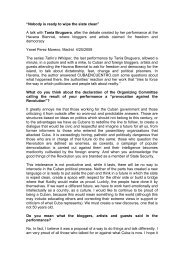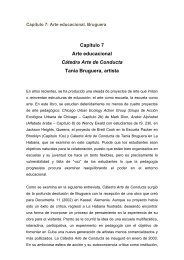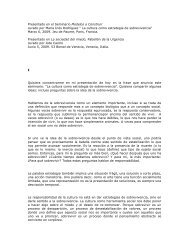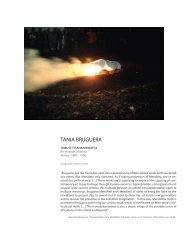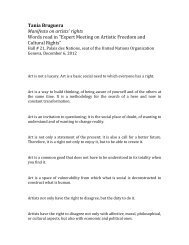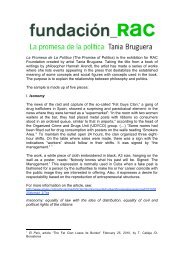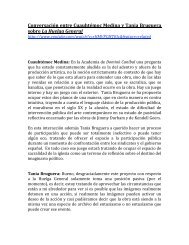Download PDF - Tania Bruguera
Download PDF - Tania Bruguera
Download PDF - Tania Bruguera
Create successful ePaper yourself
Turn your PDF publications into a flip-book with our unique Google optimized e-Paper software.
54. <strong>Bruguera</strong>, ‘When Behavior Becomes Form’,<br />
p. 67.<br />
55. Carrie Lambert-Beatty, ‘Political People:<br />
Notes on Arte de Conducta’, in <strong>Tania</strong> <strong>Bruguera</strong>: On<br />
the Political Imaginary (Edizoni Charta srl: Milano,<br />
2009), p. 43.<br />
56. Claire Bishop, ‘The Social Turn:<br />
Collaboration and Its Discontents’, Artforum, vol.<br />
44, no. 6, February 2006, p. 179. Lambert-<br />
Beatty contextualises <strong>Bruguera</strong>’s practice around<br />
the ‘fall’ by comparing it to the work of Artur<br />
Zmijewski.<br />
57. Bishop, ‘The Social Turn’, p. 180. (Emphasis<br />
in the original.) See as well Bishop, ‘Antagonism<br />
and Relational Aesthetics’, October, vol. 110, Fall<br />
2004, pp. 51–79.<br />
58. Debates about the definition of democracy<br />
are now quite extensive. For a recent collection of<br />
essays, see Amy Allen (ed.), Democracy in What<br />
State? trans. by William McCuaig (Columbia<br />
University Press: New York, 2011). In the<br />
context of contemporary art, see also Okwui<br />
Enwezor and others (eds), Democracy Unrealized:<br />
Documenta 11, Platform One (Hatje Cantz<br />
Publishers: Ostfildern-Ruit, 2002).<br />
59. Jacques Rancière, ‘Democracies Against<br />
Democracy: An Interview with Eric Hazan’, in<br />
Democracy in What State? pp. 76–81. See as well<br />
Kristen Ross, ‘Democracy for Sale’, in the same<br />
collection.<br />
60. Wendy Brown, ‘We are all Democrats<br />
Now...’, in Democracy in What State?, p. 44.<br />
61. <strong>Bruguera</strong>, interviewed by RoseLee<br />
Goldberg, ,http://www.taniabruguera.com/<br />
cms/46-0-Being+Cuban.htm. (accessed 10<br />
April 2011). (Emphasis added.)<br />
<strong>Tania</strong> <strong>Bruguera</strong>: Between Histories<br />
become a citizen or a criminal?’ 54 Tatlin’s Whisper # 3, which was staged in<br />
Madrid in 2006, framed this test in very explicit terms. <strong>Bruguera</strong> hired an<br />
instructor to facilitate a workshop in bomb making. Upon entering the<br />
gallery space, viewers were confronted with a table arranged with all the<br />
materials for making Molotov cocktails: glass and plastic bottles, explosives,<br />
flammable material, and aluminium foil. Tatlin’s Whisper #3 recalled the<br />
media frenzy around the 2006 ETA bombings.<br />
<strong>Bruguera</strong> is one among a number of contemporary artists seeking to turn<br />
political art away from political content and towards political action. As<br />
Carrie Lambert-Beatty has argued in her study of Arte de conducta, <strong>Bruguera</strong><br />
does not let the spectator just be. ‘Her Arte de conducta assumes’,<br />
Lambert-Beatty argues, ‘that art viewers are all “political people”. And if we<br />
are not, she makes it so.’ 55 This practice, Lambert-Beatty suggests, doubles<br />
as a critique of what Claire Bishop has named the ‘ethical turn’ in political<br />
art since the 1990s, when ‘the fall of Communism deprived the Left of the<br />
last vestiges of the Revolution that once linked political and aesthetic<br />
radicalism’. 56 Distinguishing between artistic practices that generate positive<br />
visions of sociality – that mime the State’s rhetoric to steer cultural policies<br />
towards ‘social inclusion’ – and those that ‘work critically as art’, Bishop<br />
insists that ‘truly political art’ must replay and allegorise democracy’s<br />
potential to divide and antagonise the public. 57 Bishop’s critique engages with<br />
the work of numerous philosophers, from Ernesto Laclau to Jacques<br />
Rancière, who have sought to redefine democracy in the wake of the collapse<br />
of the ‘Second World’ and the subsequent rise of neo-liberal slogans equating<br />
democracy with the free market by denying democracy’s status as a form of<br />
government. 58 Though now ‘worn out’, as Rancière has argued, democracy<br />
is less a matter of being free than ‘the capacity to do things’. 59 An ‘empty<br />
signifier’, to borrow Wendy Brown’s phrase, democracy creates the<br />
conditions for the public’s creative and political actions. 60<br />
Arte de conducta may fall under this new rubric of art that antagonises and<br />
divides its publics. Yet, to place it there conveniently ahistoricises its charge.<br />
The assimilation of <strong>Bruguera</strong>’s critique of politic art under a critique of<br />
neo-liberalism homogenises politics. It strips the work of its political<br />
specificity by denying the relationship in Cuba between art and propaganda.<br />
Much like Weiss’s assessment that Memoria is ‘proof’ that the Revolution was<br />
coming undone in the 1990s, the association of Arte de conducta with<br />
generalised antagonism eclipses the work’s origin within those media platforms<br />
(still) producing the Revolution. Memoria, for example, was printed on the<br />
same printing presses used to produce the island’s official dailies. Describing<br />
this work as ‘hyper-realistic’, <strong>Bruguera</strong> explained,<br />
I want to work with reality. Not the representation of reality. I don’t want my work to<br />
represent something. I want people to not look at it but to be in it, sometimes even<br />
without knowing it is art. This is a real situation. 61<br />
Political art, for <strong>Bruguera</strong>, transcends the field of art. It categorically denies<br />
art’s autonomy and works with or within ‘real’ systems of production.<br />
Arte de conduct is similarly ‘hyper-realistic’. It was developed in the context of<br />
<strong>Bruguera</strong>’s artistic training in Havana, when <strong>Bruguera</strong> opened her Cátedra Arte<br />
de Conducta (The School of Behavior Art). The first school of performance art<br />
in Havana, the Cátedra offered Cuban artists new educational opportunities.<br />
It also tapped into another form of media: education. Like newspapers<br />
and slogans, the Cuban government’s other most effective means of<br />
OXFORD ART JOURNAL 35.2 2012 229



